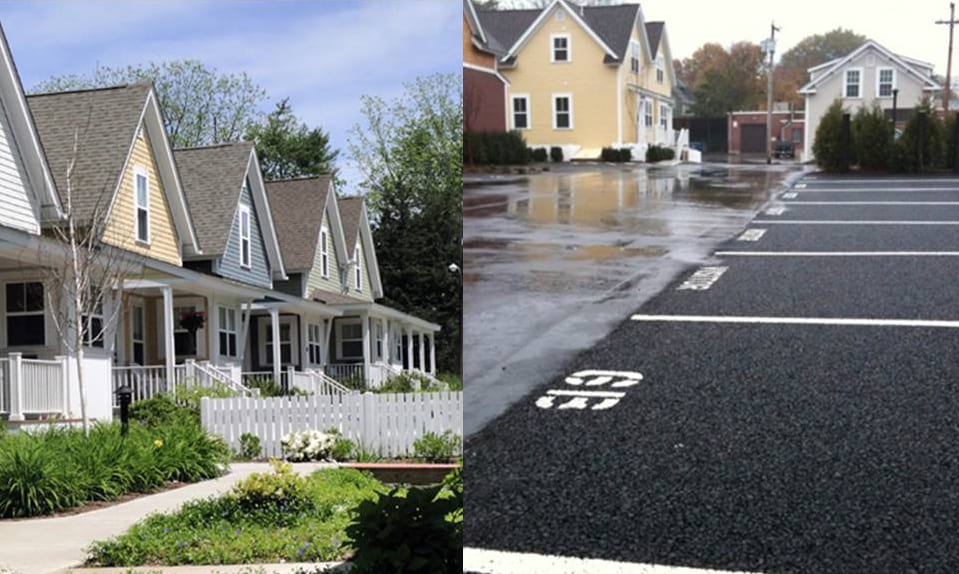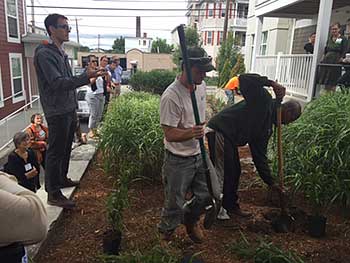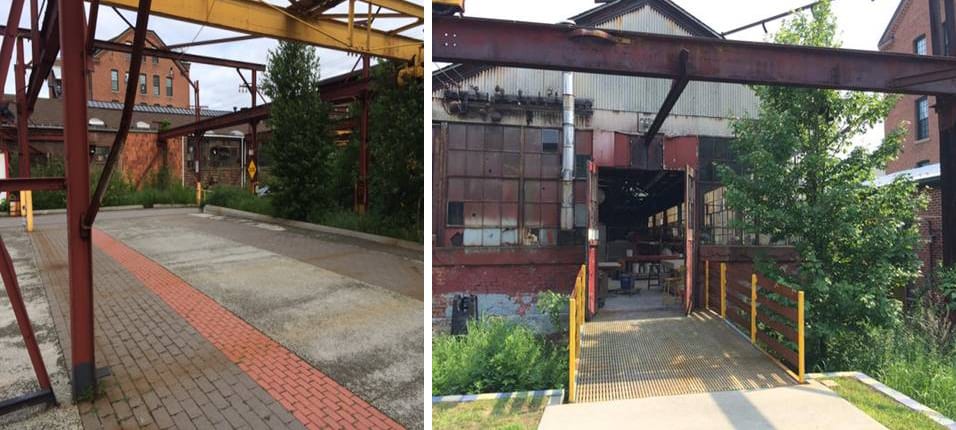by Jonathan Ford
While we undoubtedly and without exception have winning personalities away from the calculators and drafting tables, civil engineers are not typically known for expressing human emotion and feeling in infrastructure design. Infrastructure is the basic physical framework of our society, the public realm, the connective tissue, the built systems and landscape. Increased specialization between design disciplines, sprawling infrastructure, shrinking maintenance/operational funding, and an often unavoidable focus on short-term outcomes and band-aid repairs to address deferred maintenance have de-valued the importance of beauty in defining our landscape.
For many centuries, however, infrastructure was expressed as civic art – an embodiment of community pride and built to last. Over time, the art has been lost. The scales are unbalanced, tipping away from civic design and towards functional efficiency and maintenance simplicity. Green infrastructure (GI) stormwater solutions hold significant potential to contribute to a reversal of that trend, effectively addressing problems (i.e. degradation of habitat, water quality, and flooding) while also increasing community value by adding to beauty, happiness, and comfort.
We have written in the past about an evolved approach to GI. With the widespread adoption of GI and low impact development (LID) principles as a preferred site planning and landscape design approach, the importance of operation and maintenance is currently at the heart of GI/LID implementation and effectiveness. Often, perception of future maintenance challenges prevents implementation of GI in the first place in favor of more conventional engineered solutions, or worse, no improvement at all. And even once implemented, the most dazzling technological solutions lose their functional value if they are abandoned after a few years because they were too complicated to maintain, or removed due to their perceived negative aesthetic impact. Because of their simplicity and lovability, we suggest properly designed GI stormwater management practices will function consistently over a longer period of time compared to conventional engineered solutions.
What is GI, anyway? As defined by the Environmental Protection Agency, GI uses natural hydrologic features to manage water and provide environmental and community benefits. The term generally refers to site planning and stormwater management practices that mimic nature to infiltrate, evaporate, or harvest and use stormwater runoff as close to its source as possible. In other words, GI emphasizes simple site design techniques and natural stormwater practices to get rainfall filtered and back into the atmosphere and ground as close to where it falls as possible. GI can be implemented as part of public and private development projects, at a wide range of scales, and in place of or in addition to more traditional stormwater control elements. Common green infrastructure tools, or “Best Management Practices (BMPs),” include street trees, bioretention systems, and permeable pavement. GI is very often a more cost-effective stormwater management alternative compared to more highly engineered structural practices, and in addition, provides additional community benefits ranging from traffic calming to increasing aesthetics and property value.

Bioretention gardens and permeable pavement filter and infiltrate stormwater runoff – Cottages on Greene, East Greenwich, RI. Photo: Randall Arendt
Simplicity and Visibility
Conventional highly-engineered systems such as catch basins, detention basins, and hydrodynamic water quality structures often carry advanced maintenance requirements needing specialized equipment. Since the accumulation of sediment and debris is “out of sight, out of mind,” these practices are often neglected over time leading to more costly maintenance at a later date.

Conventional infrastructure treats maintenance as out-of-sight out-of-mind until it becomes a problem. Photo: esem.wmich.edu
In comparison, GI is readily accessible and easily maintained by landscape contractors as part of routine site or right-of-way maintenance activities. Removal of accumulated leaves, sediment, and debris; replacement of dead vegetation; and erosion repair, especially near the inflow point and pretreatment elements, are typical recurring GI maintenance practices. Assumed lifecycle of bioretention systems before full replacement of soil media and vegetation ranges from 10 to 25 years, depending on design, implementation, and proper maintenance. This lifecycle is comparable to that of conventional engineered practices, but typically replacement of soil media and vegetation is far less costly than replacement or repair of structural engineered systems.
For the landscape/ecological industries, GI maintenance is an opportunity to grow a pathway for jobs in the rapidly expanding green economy. For example, Rhode Island’s 2016 “Green Jobs RI” Legislative Action Plan recommends ramping up investment in workforce training programs, such as Groundwork Providence’s environmental job training program for unemployed and underemployed adults, to “match current and future workload needs while creating a stronger and more resilient Rhode Island.” In addition, simplicity, visibility, and lovability open the door to public/private partnerships where local main street organizations, neighborhood groups, and private residents and business owners are more inclined to support municipal maintenance burdens by proudly caring for GI themselves.

Groundwork Providence’s GroundCorp crew members perform maintenance on a GI installation during a funders tour. Photo: Amelia Rose
Lovability
Lovability and beauty are of course in the eye of the beholder, humans’ primal draw to water and trees as well as basic human scale and form resonate universally. A new era of cognitive science is scientifically researching the human response to the built environment. Two works in this area, Steven Mouzon’s Original Green and Ann Sussman’s cognitive architecture theory, guide our approach to community planning, infrastructure design, and GI. Previous generations built without the benefits of modern technology, creating lasting infrastructure that endured via its common sense design and community value – a living tradition of sustainability across centuries. Celebration of water and green planting elements in the built environment and connecting to the pedestrian scale human experience however possible reduces human stress and heightens a sense of safety and comfort. Whether consciously or subconsciously perceived, this sense safety and comfort translates into value – and what is loved and valuable will be tended to and cared for over time.
Celebration of water and lovable planting strategies will vary in their expression, but should always be as simple as possible, designed sensitive to scale and intensity of the built environment, and use materials consistently reflecting context. In New England’s post-industrial villages, towns, and cities, planting strategies, including street trees along with curbside bioretention/bioswale systems planted with simple grasses, serve as a greener-than-green counterpoint to the brick, steel, and glass backdrop. For example, Providence’s Steel Yard redevelopment creates multiple outdoor living room spaces of varying size utilizing a simple “urban wild” seed mix within bioretention moats to frame the streetscape as well as define transitions and thresholds between outdoor working and gathering spaces. Over five years since construction, GI elements are proudly cared for as an integral part of the Steel Yard’s identity and have helped establish pride and sense of ownership within the community at large. Changing perceptions of planting in the urban context is part of the dialogue, where to some what is seen as unkempt and shaggy may to others be vibrant and lively, consistent with a desirable urban design language and typology.
The potential for up-front cost premiums associated with lovable infrastructure must be balanced against long-term maintenance efficiencies and value generated. Often GI costs less to install and maintain than conventional engineered alternatives, while also creating green jobs and fostering community stewardship. Many states and municipalities are successfully pursuing new funding streams for lovable infrastructure addressing multiple community objectives, including environmental/watershed grants, bond initiatives, partnerships with neighborhood associations, and stormwater utility districts. Quantifying the benefits through the lenses of long-term maintenance burden and value generation can be an effective means to build support.
About the Author
 Jon Ford, P.E., Senior Project Manager – Community Design – Horsley Witten Group. Jon has 19 years of experience and is a Registered Professional Engineer in seven states. Dedicated to traditional neighborhood design, Jon is a recognized leader in the area of New Urbanist planning and design. Prior to joining HW, this focus and a devotion to interdisciplinary collaboration led Jon to found Morris Beacon Design in 2006 as a New Urbanist civil engineering and planning resource firm. Jon is a 2006 Knight Fellow in Community Building at the University of Miami’s School of Architecture, a co-founder of the New England Chapter of the Congress for the New Urbanism, and on the faculty of the Form-Based Codes Institute. Jon’s project designs have won local and national awards, including a CNU Charter Award Honorable Mention, the Rudy Bruner Award for Urban Excellence and the Boston Society of Landscape Architects Honor Award. Jon lives and works in walkable Providence, Rhode Island with his wife and two kids.
Jon Ford, P.E., Senior Project Manager – Community Design – Horsley Witten Group. Jon has 19 years of experience and is a Registered Professional Engineer in seven states. Dedicated to traditional neighborhood design, Jon is a recognized leader in the area of New Urbanist planning and design. Prior to joining HW, this focus and a devotion to interdisciplinary collaboration led Jon to found Morris Beacon Design in 2006 as a New Urbanist civil engineering and planning resource firm. Jon is a 2006 Knight Fellow in Community Building at the University of Miami’s School of Architecture, a co-founder of the New England Chapter of the Congress for the New Urbanism, and on the faculty of the Form-Based Codes Institute. Jon’s project designs have won local and national awards, including a CNU Charter Award Honorable Mention, the Rudy Bruner Award for Urban Excellence and the Boston Society of Landscape Architects Honor Award. Jon lives and works in walkable Providence, Rhode Island with his wife and two kids.
Each author appearing herein retains original copyright. Right to reproduce or disseminate all material herein, including to Columbia University Library’s CAUSEWAY Project, is otherwise reserved by ELA. Please contact ELA for permission to reprint.
Mention of products is not intended to constitute endorsement. Opinions expressed in this newsletter do not necessarily represent those of ELA’s directors, staff, or members.






